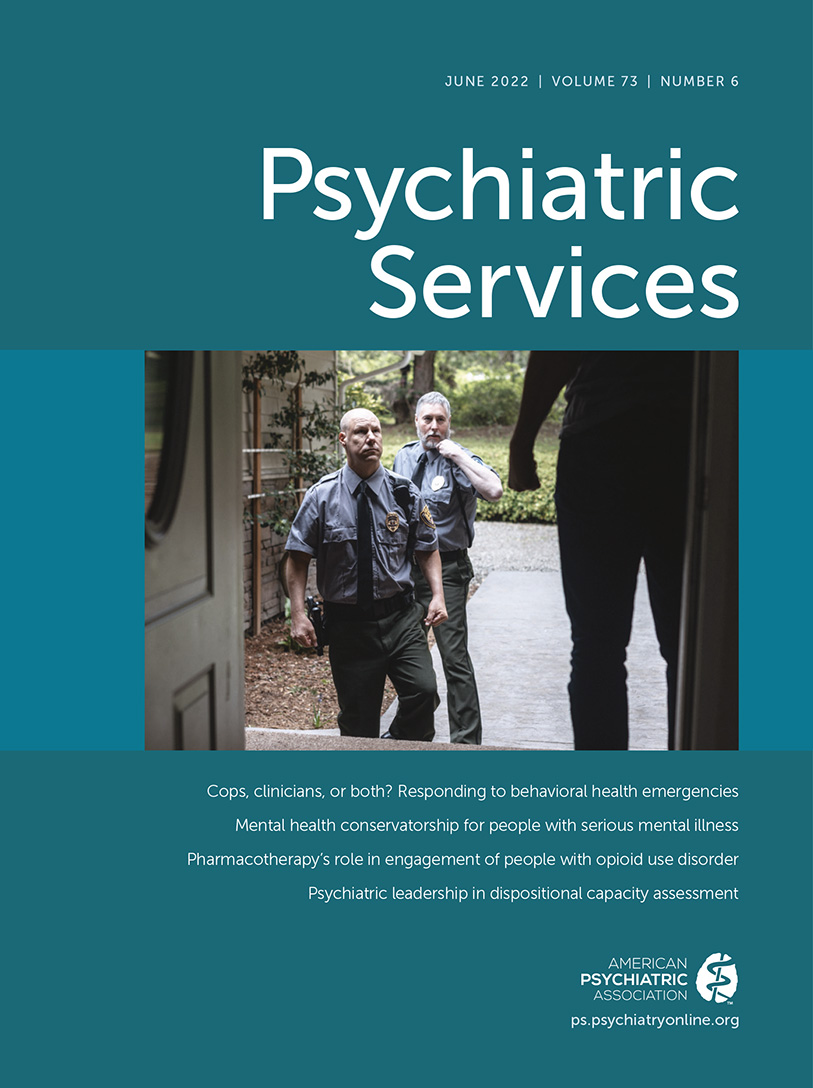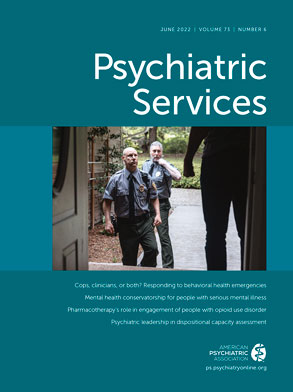Emergency department (ED) visits for suicidal ideation or suicide attempts more than doubled between 2008 and 2017, with most of these visits leading to hospitalization (
1). Risk for suicide is highest during the first 3 months after psychiatric hospitalization, approximately 100 times the global suicide rate, and it remains elevated for at least 10 years (
2). Although several treatments have been shown to be helpful in reducing suicidal ideation and behaviors in clinical trials (
3), comprehensive recovery-based treatment programs for high-risk individuals are rare; moreover, to our knowledge, no previous empirical evaluations of such programs have been conducted.
In this context, the Psychiatry High Risk Program (PHRP), a comprehensive recovery-based outpatient program for youths and young adults at high risk for suicide, was launched in 2017 at an academic medical center in central New York State. The program facilitates transitions in care and offers comprehensive and specialized treatment. It emphasizes transformative healing through psychotherapy and aims to strengthen personal and relational capacities, thereby building resilience that leads to recovery.
PROGRAM COMPONENTS
Intake at the PHRP involves a detailed patient history; clear delineation of treatment goals, tasks, and expectations; and brief psychological testing. Weekly individual psychotherapy with dynamic deconstructive psychotherapy (DDP) is a core program component. DDP was initially developed for borderline personality disorder and has been shown in randomized controlled trials to be effective for reducing depression, substance use, inpatient utilization, self-harm, and suicide attempts (
4,
5). The treatment focuses on remediating deficits in social cognition and emotion processing as well as fostering self-acceptance (
6). Treatment gains have persisted after ending DDP, suggesting that treatment effects may be transformative and long lasting (
5,
7).
The PHRP offers other treatments on an as-needed basis, including pharmacotherapy, family therapy, and group therapies. In addition, PHRP staff facilitate transitions in care through participation in inpatient team meetings, often meeting with prospective referrals while patients are still in the hospital. Admission criteria include suicidal ideation and age ≤40 years. Referrals are not accepted if the patient has been diagnosed as having autism, schizophrenia, or severe undernourishment (body mass index <18 kg/m2) or is receiving concurrent electroconvulsive therapy. The program is self-sustained through billing payments from private insurers and managed Medicaid, in approximately equal proportions.
An important innovation is that the entire treatment team, including prescribers, is trained in DDP to improve team cohesion and provide patients with a unified message. Another innovation is rigorous quality assurance, including self-rated outcome measures administered every 3 months, encouragement of video-recording sessions, and weekly peer case consultations for the therapists.
PROGRAM EVALUATION
To assess PHRP’s impact, we evaluated three outcomes over 180 days after discharge from inpatient care and referral to the PHRP. These outcomes included rehospitalization rates as assessed by chart reviews conducted by a postdoctoral psychology fellow (S.D.S.), depression severity as measured by the Patient Health Questionnaire-9 (PHQ-9), and suicidal ideation as measured by item 9 of the PHQ-9 (
8). The institutional review board of Upstate Medical University exempted this study from review because it was deemed not to constitute human subject research.
The study sample consisted of consecutive referrals to the PHRP from the adult inpatient psychiatry unit at University Hospital, Upstate Medical University, between February 20, 2017 (when PHRP was established), and May 28, 2019. Of 45 total referrals over this period, 32 completed the intake at the PHRP and constituted the intent-to-treat sample. The 13 referrals who did not transition to the PHRP did not differ significantly from the study sample in age, gender, race-ethnicity, marital status, employment, or inpatient length of stay. However, the 13 nonparticipants reported lower levels of depression (t=3.21, df=43, p<0.001) and fewer previous suicide attempts (t=2.72, df=43, p=0.01); moreover, at discharge, fewer of the nonparticipants were diagnosed as having trauma- and stressor-related disorders (χ2=4.68, df=1, p=0.03), suggesting that patients with more severe disorders and at higher suicide risk may have been more likely to successfully transition to PHRP.
Inpatient utilization of the PHRP study sample (N=32) at 30, 90, and 180 days after discharge was compared with that of a historical cohort (receiving treatment as usual) of 32 patients matched for PHRP admission criteria and referred to usual care in the community. The treatment-as-usual sample was derived from a quality improvement initiative conducted just before the advent of PHRP among patients admitted for suicidality to the same inpatient unit (
9). (Details about the treatments offered to this sample are given below.) Because inpatient utilization exhibited skewed distributions, between-group differences were assessed with the Mann-Whitney U test; within-group changes over time were assessed with the Wilcoxon signed-rank test. The 6-month rehospitalization rates of all 64 participants were included in this analysis regardless of whether they dropped out of treatment during the study period.
We conducted a separate analysis of PHQ-9 scores for the 20 participants who remained in treatment at the PHRP during the entire study period to determine the program’s impact on depression and suicide risk. We used one-way, repeated-measures analysis of variance with time as the repeated-measures factor at 90 and 180 days postdischarge. A significance level of p=0.05 was used for all statistical comparisons (two-tailed). We conducted all analyses with IBM SPSS Statistics, version 27.
OUTPATIENT TREATMENT
PHRP participants received a mean±SD of 15.6±7.6 DDP sessions and made 3.5±2.8 psychopharmacology visits during the study period. No participants in this sample received supplemental family or group therapy. DDP was administered by four therapists, including three licensed clinical social workers and a psychiatric nurse practitioner. Pharmacotherapy was provided by a psychiatrist and nurse practitioner.
Treatment-as-usual participants (N=32) received referrals to appointments within 7 days of discharge at mental health clinics (N=22), co-occurring disorder programs (N=6), private therapists (N=3), and day treatment programs (N=1). Although a data-sharing agreement was in place among regional hospitals to reliably ascertain inpatient utilization, most outpatient mental health agencies used a separate medical record; therefore, it is uncertain how many of the treatment-as-usual participants kept their appointments and received treatment. A chart review of the 11 treatment-as-usual participants who were readmitted showed that seven (64%) were prescribed psychotropic medications and taking them at readmission, and seven (64%) were receiving outpatient psychotherapy.
COMPARISON OF COHORTS
Most participants were female (69%, N=44), White (83%, N=53), and never married (86%, N=55), with a mean age of 26.8±7.0 years. No statistically significant differences were found between PHRP and treatment-as-usual participants with regard to age, number of recent suicide attempts (i.e., within 90 days of index admission), lethality of previous suicide attempts, employment status, family history of suicide attempts, and comorbid substance use disorders. PHRP participants were more likely to have better family support, female gender, a diagnosis of borderline personality disorder, higher PHQ-9 scores and suicidal ideation, and past suicide attempts. (A table showing the participant characteristics by group is available as an
online supplement to this column.) However, none of these variables significantly predicted rehospitalization in multivariate analyses.
Inpatient service use differed significantly between the two cohorts over the 6 months after discharge. As shown in
Table 1, PHRP participants had no psychiatric rehospitalizations and had almost 80% fewer ED visits, although ED visits were not statistically different between the two cohorts. Participants receiving treatment as usual spent on average >6 days in the hospital over 180 days postdischarge, in contrast to no days for PHRP participants.
Among the PHRP participants, PHQ-9 scores decreased from a mean of 20.4±3.25 at intake to 13.1±5.93 at 180 days postdischarge, indicating a significant decrease over time (Wilks’ λ=0.41; F=27.7, df=1, 19, p<0.01; ηp2=0.59). Item 9 (suicidal ideation) decreased from a mean of 2.00±0.97 at intake to 0.75±0.79 at 180 days postdischarge, also indicating a significant decrease over time (Wilks’ λ=0.47; F=21.4, df=1, 19, p<0.01; ηp2=0.53). Each pairwise difference was statistically significant (p<0.01) at each assessment point of 90 and 180 days.
DISCUSSION AND CONCLUSIONS
Patients who successfully transitioned to PHRP did not need to be rehospitalized over the 6 months in the program, and they had few ED visits. By contrast, a matched historical cohort receiving usual care in the community displayed high rates of psychiatric rehospitalizations. In total, 34% (N=11) of the PHRP cohort were readmitted within 6 months, consistent with findings of a previous study reporting a 42% readmission rate within 12 months (
10). PHRP participants displayed other markers of decreased suicide risk over the study period, including large and statistically significant reductions in depression severity and suicidal ideation. Although we could not attribute symptom improvement to PHRP participation because of the lack of adequate control groups, these changes suggest potential program effectiveness.
The PHRP has been financially self-sustaining and scalable, with approximately 50% annual growth of new intakes since 2017. Potential barriers to implementation in other regions include start-up costs for administration and training as well as variable levels of insurance reimbursement for weekly psychotherapy.
Innovative aspects of PHRP include a specialized and comprehensive treatment for individuals at high risk for suicide, facilitation of transitions in care, a cohesive health care team that uses a common framework, regular outcome and risk assessments, and weekly, manual-based psychotherapy aiming for recovery. To tease apart whether each of these components is essential, additional research is needed to prospectively compare the cost-effectiveness of a PHRP-type model with that of usual care supplemented by brief interventions enhancing treatment engagement (
11).
Limitations of this study included a retrospective cohort design lacking randomization, differences between groups on some baseline variables, insufficient information regarding outpatient treatment of the treatment-as-usual participants, lack of a measure for suicide attempts and self-harm, and possible author allegiance bias. Nevertheless, the study provides preliminary evidence that a recovery-based model of suicide prevention can be feasible, sustainable, and effective in reducing suicide risk and inpatient stays. Future research is needed to establish cost-effectiveness and replicability of this model in other health care systems.

